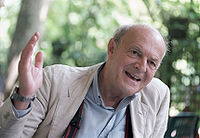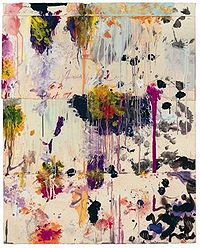Cy Twombly
Cy Twombly (Edwin Parker Twombly, Jr.) (Lexington, Virginia, 1928 – Rome, Italy, 2011) was an American painter and sculpture. From 1948 to 1951 he attended the School of the Museum of Fine Arts in Boston, MA. and in 1948 - 1951 he attended Washington & Lee University, Lexington, VA. In 1951-1952, at the Art Students League, New York, NY. and Black Mountain College, Beria, NC. In 1952 Travelling Grant, The Richmond Art Museum. The most influential person on his formative years was the Spanish artist Pierre Duara. [1]
Twombly was a recipient of numerous awards; in 2001 he was the winner of the Leone d'Oro for Contemporary Art at the Venice Biennale (he was already invited to exhibit his work at the Venice Biennale in 1964 and 1989 where his works were described as “almost Monet-like in their atmospheric brushwork and all-over patterns” [2]). Another important award: In the spring of 2010, after several years in the making, Twombly's monumental ceiling painting, measuring nearly four-hundred square metres, was inaugurated at the Salle des Bronzes in the Louvre, Paris. [3]
Since 1951 Twomble had exhibitions in places like: The Seven Stars Gallery Chicago, IL, La Tartaruga Rome, Italy, Milwaukee Art Center Milwaukee, WI, Institute of Contemporary Art Philadelphia, PA, Galerie Karsten Greve Cologne, Germany, Galerie Karsten Greve. Cologne, Germany (solo), Gagosian Gallery. Los Angeles, CA (solo), Pinakothek der Moderne. Munich, Germany (solo), State Hermitage Museum. St. Petersburg, Alte Pinakothek der Moderne, Munich (solo), Tate Modern, London, England (solo), Guggenheim Bilbao Museo, The Art Institute of Chicago (solo), and the Musée du Louvre, Paris; his last exhibition was in 2011 in the Museum Brandhorst, Munich.
Twombly’s work sold for millions and, though often difficult to understand, inspired fevered devotion once it took hold in the viewer. [4]
The Daily Telegraph described Twombly as “a rare spirit ... who paints like no one else and who explores a realm of feeling touched only by the greatest poets”. [5]
Writing and language served as major conceptual foundations for Twombly's art; the written word, in the form of poems, myths and histories, inspired much of his work. He focused on the process of writing, both by sketching words directly onto the canvas and by creating line- and handwriting-based compositions. [6]
See also
External links
- Biography.
- Cy Twombly.
- Cy Twombly. Official site.




